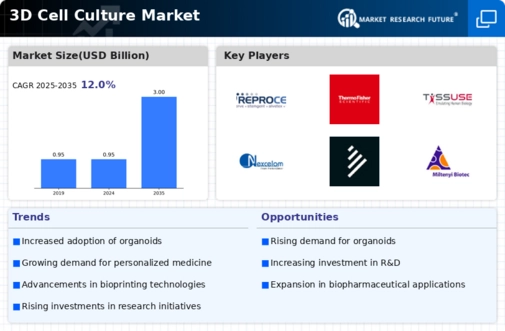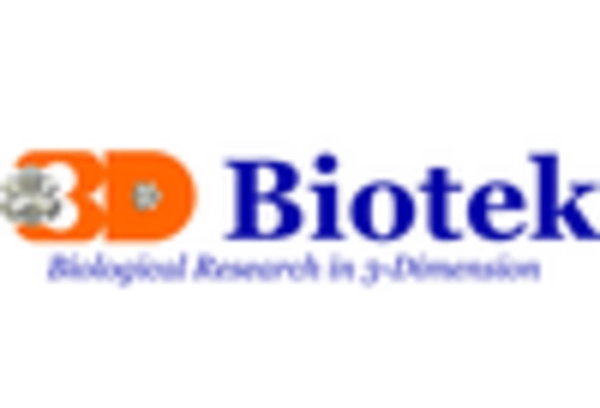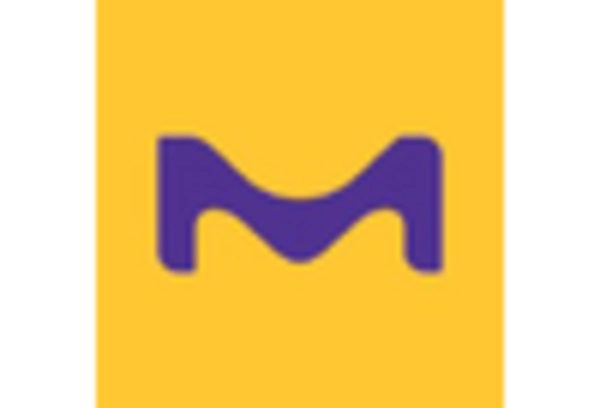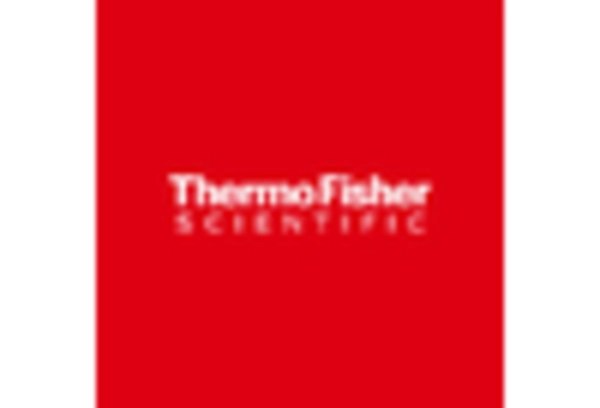Drug Discovery
Toxicology Testing
Regenerative Medicine
Cancer Research
Spheroid Culture
Organ-on-a-Chip
Microfluidics
Bioreactor Systems
Pharmaceutical Companies
Biotechnology Companies
Academic Research Institutes
CROs
Reagents
Instruments
Services
North America
Europe
South America
Asia Pacific
Middle East and Africa
North America Outlook (USD Billion, 2019-2035)
North America 3D Cell Culture Market by Application Type
Drug Discovery
Toxicology Testing
Regenerative Medicine
Cancer Research
North America 3D Cell Culture Market by Technique Type
Spheroid Culture
Organ-on-a-Chip
Microfluidics
Bioreactor Systems
North America 3D Cell Culture Market by End Use Type
Pharmaceutical Companies
Biotechnology Companies
Academic Research Institutes
CROs
North America 3D Cell Culture Market by Product Type
Reagents
Instruments
Services
North America 3D Cell Culture Market by Regional Type
US
Canada
US Outlook (USD Billion, 2019-2035)
US 3D Cell Culture Market by Application Type
Drug Discovery
Toxicology Testing
Regenerative Medicine
Cancer Research
US 3D Cell Culture Market by Technique Type
Spheroid Culture
Organ-on-a-Chip
Microfluidics
Bioreactor Systems
US 3D Cell Culture Market by End Use Type
Pharmaceutical Companies
Biotechnology Companies
Academic Research Institutes
CROs
US 3D Cell Culture Market by Product Type
Reagents
Instruments
Services
CANADA Outlook (USD Billion, 2019-2035)
CANADA 3D Cell Culture Market by Application Type
Drug Discovery
Toxicology Testing
Regenerative Medicine
Cancer Research
CANADA 3D Cell Culture Market by Technique Type
Spheroid Culture
Organ-on-a-Chip
Microfluidics
Bioreactor Systems
CANADA 3D Cell Culture Market by End Use Type
Pharmaceutical Companies
Biotechnology Companies
Academic Research Institutes
CROs
CANADA 3D Cell Culture Market by Product Type
Reagents
Instruments
Services
Europe Outlook (USD Billion, 2019-2035)
Europe 3D Cell Culture Market by Application Type
Drug Discovery
Toxicology Testing
Regenerative Medicine
Cancer Research
Europe 3D Cell Culture Market by Technique Type
Spheroid Culture
Organ-on-a-Chip
Microfluidics
Bioreactor Systems
Europe 3D Cell Culture Market by End Use Type
Pharmaceutical Companies
Biotechnology Companies
Academic Research Institutes
CROs
Europe 3D Cell Culture Market by Product Type
Reagents
Instruments
Services
Europe 3D Cell Culture Market by Regional Type
Germany
UK
France
Russia
Italy
Spain
Rest of Europe
GERMANY Outlook (USD Billion, 2019-2035)
GERMANY 3D Cell Culture Market by Application Type
Drug Discovery
Toxicology Testing
Regenerative Medicine
Cancer Research
GERMANY 3D Cell Culture Market by Technique Type
Spheroid Culture
Organ-on-a-Chip
Microfluidics
Bioreactor Systems
GERMANY 3D Cell Culture Market by End Use Type
Pharmaceutical Companies
Biotechnology Companies
Academic Research Institutes
CROs
GERMANY 3D Cell Culture Market by Product Type
Reagents
Instruments
Services
UK Outlook (USD Billion, 2019-2035)
UK 3D Cell Culture Market by Application Type
Drug Discovery
Toxicology Testing
Regenerative Medicine
Cancer Research
UK 3D Cell Culture Market by Technique Type
Spheroid Culture
Organ-on-a-Chip
Microfluidics
Bioreactor Systems
UK 3D Cell Culture Market by End Use Type
Pharmaceutical Companies
Biotechnology Companies
Academic Research Institutes
CROs
UK 3D Cell Culture Market by Product Type
Reagents
Instruments
Services
FRANCE Outlook (USD Billion, 2019-2035)
FRANCE 3D Cell Culture Market by Application Type
Drug Discovery
Toxicology Testing
Regenerative Medicine
Cancer Research
FRANCE 3D Cell Culture Market by Technique Type
Spheroid Culture
Organ-on-a-Chip
Microfluidics
Bioreactor Systems
FRANCE 3D Cell Culture Market by End Use Type
Pharmaceutical Companies
Biotechnology Companies
Academic Research Institutes
CROs
FRANCE 3D Cell Culture Market by Product Type
Reagents
Instruments
Services
RUSSIA Outlook (USD Billion, 2019-2035)
RUSSIA 3D Cell Culture Market by Application Type
Drug Discovery
Toxicology Testing
Regenerative Medicine
Cancer Research
RUSSIA 3D Cell Culture Market by Technique Type
Spheroid Culture
Organ-on-a-Chip
Microfluidics
Bioreactor Systems
RUSSIA 3D Cell Culture Market by End Use Type
Pharmaceutical Companies
Biotechnology Companies
Academic Research Institutes
CROs
RUSSIA 3D Cell Culture Market by Product Type
Reagents
Instruments
Services
ITALY Outlook (USD Billion, 2019-2035)
ITALY 3D Cell Culture Market by Application Type
Drug Discovery
Toxicology Testing
Regenerative Medicine
Cancer Research
ITALY 3D Cell Culture Market by Technique Type
Spheroid Culture
Organ-on-a-Chip
Microfluidics
Bioreactor Systems
ITALY 3D Cell Culture Market by End Use Type
Pharmaceutical Companies
Biotechnology Companies
Academic Research Institutes
CROs
ITALY 3D Cell Culture Market by Product Type
Reagents
Instruments
Services
SPAIN Outlook (USD Billion, 2019-2035)
SPAIN 3D Cell Culture Market by Application Type
Drug Discovery
Toxicology Testing
Regenerative Medicine
Cancer Research
SPAIN 3D Cell Culture Market by Technique Type
Spheroid Culture
Organ-on-a-Chip
Microfluidics
Bioreactor Systems
SPAIN 3D Cell Culture Market by End Use Type
Pharmaceutical Companies
Biotechnology Companies
Academic Research Institutes
CROs
SPAIN 3D Cell Culture Market by Product Type
Reagents
Instruments
Services
REST OF EUROPE Outlook (USD Billion, 2019-2035)
REST OF EUROPE 3D Cell Culture Market by Application Type
Drug Discovery
Toxicology Testing
Regenerative Medicine
Cancer Research
REST OF EUROPE 3D Cell Culture Market by Technique Type
Spheroid Culture
Organ-on-a-Chip
Microfluidics
Bioreactor Systems
REST OF EUROPE 3D Cell Culture Market by End Use Type
Pharmaceutical Companies
Biotechnology Companies
Academic Research Institutes
CROs
REST OF EUROPE 3D Cell Culture Market by Product Type
Reagents
Instruments
Services
APAC Outlook (USD Billion, 2019-2035)
APAC 3D Cell Culture Market by Application Type
Drug Discovery
Toxicology Testing
Regenerative Medicine
Cancer Research
APAC 3D Cell Culture Market by Technique Type
Spheroid Culture
Organ-on-a-Chip
Microfluidics
Bioreactor Systems
APAC 3D Cell Culture Market by End Use Type
Pharmaceutical Companies
Biotechnology Companies
Academic Research Institutes
CROs
APAC 3D Cell Culture Market by Product Type
Reagents
Instruments
Services
APAC 3D Cell Culture Market by Regional Type
China
India
Japan
South Korea
Malaysia
Thailand
Indonesia
Rest of APAC
CHINA Outlook (USD Billion, 2019-2035)
CHINA 3D Cell Culture Market by Application Type
Drug Discovery
Toxicology Testing
Regenerative Medicine
Cancer Research
CHINA 3D Cell Culture Market by Technique Type
Spheroid Culture
Organ-on-a-Chip
Microfluidics
Bioreactor Systems
CHINA 3D Cell Culture Market by End Use Type
Pharmaceutical Companies
Biotechnology Companies
Academic Research Institutes
CROs
CHINA 3D Cell Culture Market by Product Type
Reagents
Instruments
Services
INDIA Outlook (USD Billion, 2019-2035)
INDIA 3D Cell Culture Market by Application Type
Drug Discovery
Toxicology Testing
Regenerative Medicine
Cancer Research
INDIA 3D Cell Culture Market by Technique Type
Spheroid Culture
Organ-on-a-Chip
Microfluidics
Bioreactor Systems
INDIA 3D Cell Culture Market by End Use Type
Pharmaceutical Companies
Biotechnology Companies
Academic Research Institutes
CROs
INDIA 3D Cell Culture Market by Product Type
Reagents
Instruments
Services
JAPAN Outlook (USD Billion, 2019-2035)
JAPAN 3D Cell Culture Market by Application Type
Drug Discovery
Toxicology Testing
Regenerative Medicine
Cancer Research
JAPAN 3D Cell Culture Market by Technique Type
Spheroid Culture
Organ-on-a-Chip
Microfluidics
Bioreactor Systems
JAPAN 3D Cell Culture Market by End Use Type
Pharmaceutical Companies
Biotechnology Companies
Academic Research Institutes
CROs
JAPAN 3D Cell Culture Market by Product Type
Reagents
Instruments
Services
SOUTH KOREA Outlook (USD Billion, 2019-2035)
SOUTH KOREA 3D Cell Culture Market by Application Type
Drug Discovery
Toxicology Testing
Regenerative Medicine
Cancer Research
SOUTH KOREA 3D Cell Culture Market by Technique Type
Spheroid Culture
Organ-on-a-Chip
Microfluidics
Bioreactor Systems
SOUTH KOREA 3D Cell Culture Market by End Use Type
Pharmaceutical Companies
Biotechnology Companies
Academic Research Institutes
CROs
SOUTH KOREA 3D Cell Culture Market by Product Type
Reagents
Instruments
Services
MALAYSIA Outlook (USD Billion, 2019-2035)
MALAYSIA 3D Cell Culture Market by Application Type
Drug Discovery
Toxicology Testing
Regenerative Medicine
Cancer Research
MALAYSIA 3D Cell Culture Market by Technique Type
Spheroid Culture
Organ-on-a-Chip
Microfluidics
Bioreactor Systems
MALAYSIA 3D Cell Culture Market by End Use Type
Pharmaceutical Companies
Biotechnology Companies
Academic Research Institutes
CROs
MALAYSIA 3D Cell Culture Market by Product Type
Reagents
Instruments
Services
THAILAND Outlook (USD Billion, 2019-2035)
THAILAND 3D Cell Culture Market by Application Type
Drug Discovery
Toxicology Testing
Regenerative Medicine
Cancer Research
THAILAND 3D Cell Culture Market by Technique Type
Spheroid Culture
Organ-on-a-Chip
Microfluidics
Bioreactor Systems
THAILAND 3D Cell Culture Market by End Use Type
Pharmaceutical Companies
Biotechnology Companies
Academic Research Institutes
CROs
THAILAND 3D Cell Culture Market by Product Type
Reagents
Instruments
Services
INDONESIA Outlook (USD Billion, 2019-2035)
INDONESIA 3D Cell Culture Market by Application Type
Drug Discovery
Toxicology Testing
Regenerative Medicine
Cancer Research
INDONESIA 3D Cell Culture Market by Technique Type
Spheroid Culture
Organ-on-a-Chip
Microfluidics
Bioreactor Systems
INDONESIA 3D Cell Culture Market by End Use Type
Pharmaceutical Companies
Biotechnology Companies
Academic Research Institutes
CROs
INDONESIA 3D Cell Culture Market by Product Type
Reagents
Instruments
Services
REST OF APAC Outlook (USD Billion, 2019-2035)
REST OF APAC 3D Cell Culture Market by Application Type
Drug Discovery
Toxicology Testing
Regenerative Medicine
Cancer Research
REST OF APAC 3D Cell Culture Market by Technique Type
Spheroid Culture
Organ-on-a-Chip
Microfluidics
Bioreactor Systems
REST OF APAC 3D Cell Culture Market by End Use Type
Pharmaceutical Companies
Biotechnology Companies
Academic Research Institutes
CROs
REST OF APAC 3D Cell Culture Market by Product Type
Reagents
Instruments
Services
South America Outlook (USD Billion, 2019-2035)
South America 3D Cell Culture Market by Application Type
Drug Discovery
Toxicology Testing
Regenerative Medicine
Cancer Research
South America 3D Cell Culture Market by Technique Type
Spheroid Culture
Organ-on-a-Chip
Microfluidics
Bioreactor Systems
South America 3D Cell Culture Market by End Use Type
Pharmaceutical Companies
Biotechnology Companies
Academic Research Institutes
CROs
South America 3D Cell Culture Market by Product Type
Reagents
Instruments
Services
South America 3D Cell Culture Market by Regional Type
Brazil
Mexico
Argentina
Rest of South America
BRAZIL Outlook (USD Billion, 2019-2035)
BRAZIL 3D Cell Culture Market by Application Type
Drug Discovery
Toxicology Testing
Regenerative Medicine
Cancer Research
BRAZIL 3D Cell Culture Market by Technique Type
Spheroid Culture
Organ-on-a-Chip
Microfluidics
Bioreactor Systems
BRAZIL 3D Cell Culture Market by End Use Type
Pharmaceutical Companies
Biotechnology Companies
Academic Research Institutes
CROs
BRAZIL 3D Cell Culture Market by Product Type
Reagents
Instruments
Services
MEXICO Outlook (USD Billion, 2019-2035)
MEXICO 3D Cell Culture Market by Application Type
Drug Discovery
Toxicology Testing
Regenerative Medicine
Cancer Research
MEXICO 3D Cell Culture Market by Technique Type
Spheroid Culture
Organ-on-a-Chip
Microfluidics
Bioreactor Systems
MEXICO 3D Cell Culture Market by End Use Type
Pharmaceutical Companies
Biotechnology Companies
Academic Research Institutes
CROs
MEXICO 3D Cell Culture Market by Product Type
Reagents
Instruments
Services
ARGENTINA Outlook (USD Billion, 2019-2035)
ARGENTINA 3D Cell Culture Market by Application Type
Drug Discovery
Toxicology Testing
Regenerative Medicine
Cancer Research
ARGENTINA 3D Cell Culture Market by Technique Type
Spheroid Culture
Organ-on-a-Chip
Microfluidics
Bioreactor Systems
ARGENTINA 3D Cell Culture Market by End Use Type
Pharmaceutical Companies
Biotechnology Companies
Academic Research Institutes
CROs
ARGENTINA 3D Cell Culture Market by Product Type
Reagents
Instruments
Services
REST OF SOUTH AMERICA Outlook (USD Billion, 2019-2035)
REST OF SOUTH AMERICA 3D Cell Culture Market by Application Type
Drug Discovery
Toxicology Testing
Regenerative Medicine
Cancer Research
REST OF SOUTH AMERICA 3D Cell Culture Market by Technique Type
Spheroid Culture
Organ-on-a-Chip
Microfluidics
Bioreactor Systems
REST OF SOUTH AMERICA 3D Cell Culture Market by End Use Type
Pharmaceutical Companies
Biotechnology Companies
Academic Research Institutes
CROs
REST OF SOUTH AMERICA 3D Cell Culture Market by Product Type
Reagents
Instruments
Services
MEA Outlook (USD Billion, 2019-2035)
MEA 3D Cell Culture Market by Application Type
Drug Discovery
Toxicology Testing
Regenerative Medicine
Cancer Research
MEA 3D Cell Culture Market by Technique Type
Spheroid Culture
Organ-on-a-Chip
Microfluidics
Bioreactor Systems
MEA 3D Cell Culture Market by End Use Type
Pharmaceutical Companies
Biotechnology Companies
Academic Research Institutes
CROs
MEA 3D Cell Culture Market by Product Type
Reagents
Instruments
Services
MEA 3D Cell Culture Market by Regional Type
GCC Countries
South Africa
Rest of MEA
GCC COUNTRIES Outlook (USD Billion, 2019-2035)
GCC COUNTRIES 3D Cell Culture Market by Application Type
Drug Discovery
Toxicology Testing
Regenerative Medicine
Cancer Research
GCC COUNTRIES 3D Cell Culture Market by Technique Type
Spheroid Culture
Organ-on-a-Chip
Microfluidics
Bioreactor Systems
GCC COUNTRIES 3D Cell Culture Market by End Use Type
Pharmaceutical Companies
Biotechnology Companies
Academic Research Institutes
CROs
GCC COUNTRIES 3D Cell Culture Market by Product Type
Reagents
Instruments
Services
SOUTH AFRICA Outlook (USD Billion, 2019-2035)
SOUTH AFRICA 3D Cell Culture Market by Application Type
Drug Discovery
Toxicology Testing
Regenerative Medicine
Cancer Research
SOUTH AFRICA 3D Cell Culture Market by Technique Type
Spheroid Culture
Organ-on-a-Chip
Microfluidics
Bioreactor Systems
SOUTH AFRICA 3D Cell Culture Market by End Use Type
Pharmaceutical Companies
Biotechnology Companies
Academic Research Institutes
CROs
SOUTH AFRICA 3D Cell Culture Market by Product Type
Reagents
Instruments
Services
REST OF MEA Outlook (USD Billion, 2019-2035)
REST OF MEA 3D Cell Culture Market by Application Type
Drug Discovery
Toxicology Testing
Regenerative Medicine
Cancer Research
REST OF MEA 3D Cell Culture Market by Technique Type
Spheroid Culture
Organ-on-a-Chip
Microfluidics
Bioreactor Systems
REST OF MEA 3D Cell Culture Market by End Use Type
Pharmaceutical Companies
Biotechnology Companies
Academic Research Institutes
CROs
REST OF MEA 3D Cell Culture Market by Product Type
Reagents
Instruments
Services









Leave a Comment